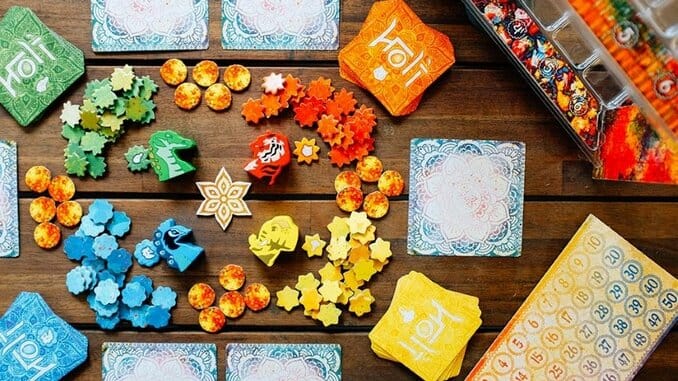Holi Is a Beautiful Board Game That Prioritizes Strategy Over Luck
Images courtesy of Floodgate Games
We’ve already had several new game releases this winter that stand out for their incredible visuals—Canvas, which I reviewed two weeks ago, has some of the best art I’ve ever seen on a game, while Cloud City has a great 3-D concept that fell flat in game play. Holi, the newest release from Floodgate Games, takes 3-D even further, with a three-tiered board that might remind you a bit of 3-D chess, and an explosion of color that draws inspiration from the Hindu festival by that name that begins at the end of this month. It’s a surprisingly rich game for its short rule set, and the lack of any real random elements means your skill in playing your cards and moving your token will determine whether you win.
Holi’s board is a showstopper: it has three levels of clear plastic trays with grids in which you can place player tokens, sweets, and flowers during the game, held up by four cardboard pieces at the corners. Players start on the corner spaces of the bottom tray, and over the course of the game will play cards from their hands to ‘throw’ flowers in designated patterns on the tray where their tokens stand. They’ll also have the chance to climb to higher levels, with flowers of your color worth more points the higher they sit when the game ends. There’s a catch, of course: when you throw flowers on to spaces with nothing below them, the flowers will fall ‘through’ the tray (not literally) to the one below, and perhaps all the way to the bottom. There are 16 sweets tokens on the bottom two levels, which you can collect while moving your player token to try to get a game-end bonus.
Each player has their own player token and a pile of flowers in their specific color. On a turn, they’ll play one of the aforementioned color cards with a pattern showing a 3×3 grid with three squares filled in with their specific color. Some cards also show a symbol for their player token in a fourth square on the grid. If the card does show that, the player must place their own flower tokens in that pattern on the level where their player token sits, and the pattern must include the space with their player token on it shown on the card. If the card doesn’t show the token symbol, then the player’s token must take one of the three colored spaces on the card, with flowers going into the other two.
This is simple enough when the game starts, but once flowers are out there, your options narrow, because you can’t place one of your flowers on a space with another flower—yours or anyone else’s—on it. You can throw a flower to a space holding another player’s token, which scores you one point for a Direct Hit, and then lets you place your flower in the other player’s supply for another two points at game end. (If you throw a flower into a space above another player’s token, so that it would fall through on to them, you don’t get the first bonus but still place your flower in their supply.) There are two ways to avoid a situation where you can’t make a legal play, which would force you out of the game. You can skip the color pattern and place a single flower anywhere on your level of the board, although you can’t do this on consecutive turns. And you have an optional action on every turn to move your player token to any space on your level, thus setting up a possible move for the subsequent turn. If you move into a space with a flower on it, you take that token, with no penalty if it’s your own but a two point bonus for your opponent if you take one of theirs.

-

-

-

-

-

-

-

-

-

-

-

-

-

-

-

-

-

-

-

-

-

-

-

-

-

-

-

-

-

-

-

-

-

-

-

-

-

-

-

-








































